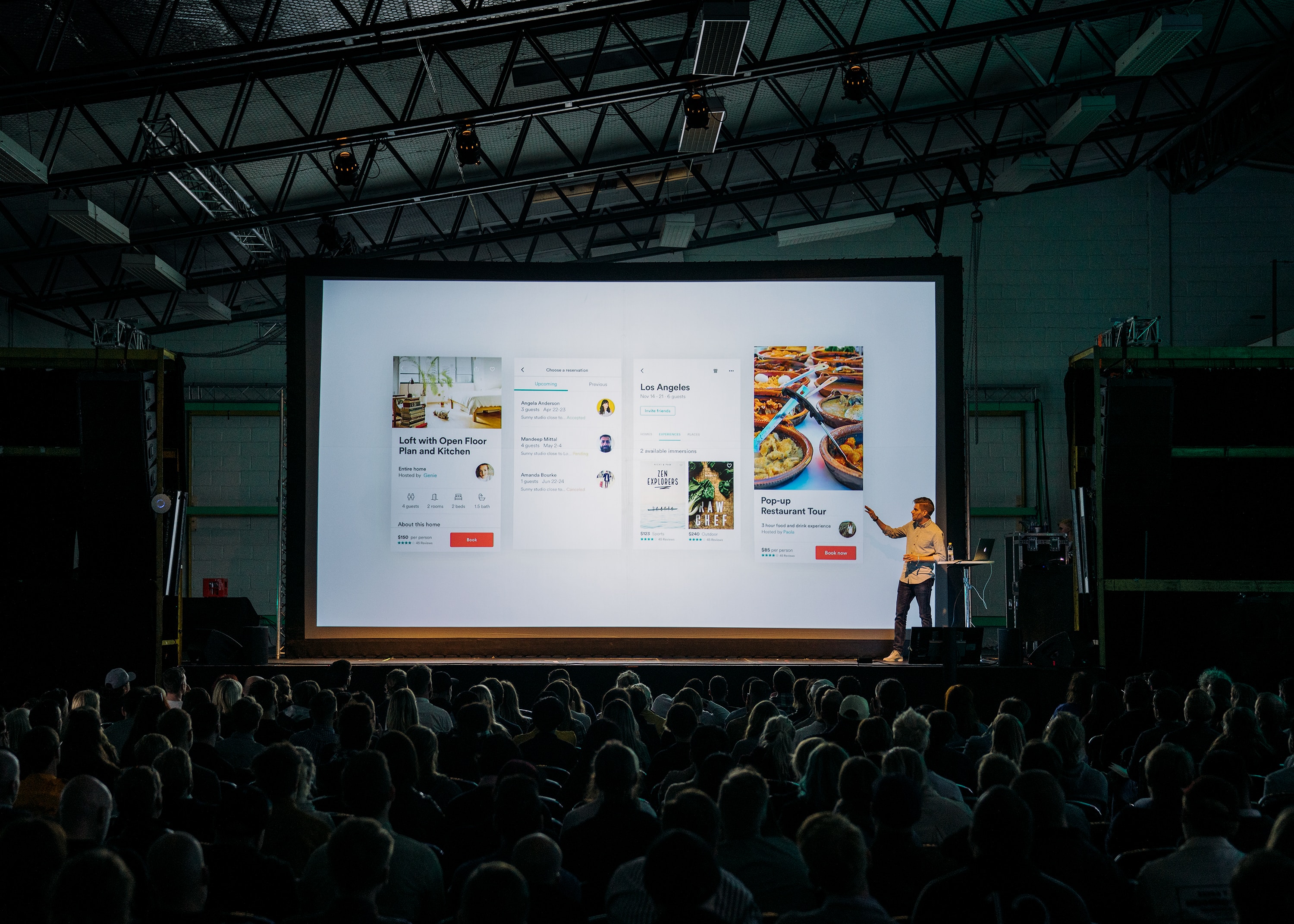September 5, 2019
 by Elise Hanslip / September 5, 2019
by Elise Hanslip / September 5, 2019

Are you looking for new ways to enhance your event communications to drive early ticket sales, deliver important information, or gather feedback post-event?
Planning a timeline and content for your event communications can be a huge task, but this guide is packed with plenty of actionable tips to apply to your event, no matter the industry.
To get started, you need to make sure your event communications are in check. This is where brand, tone, and voice come into play.
To kick-off, let’s discuss your event brand. It’s important your event looks and feels consistent throughout the whole attendee journey. The goal is to create a verbal and visual structure to adhere to.
Here are some questions to help you define event brand, tone, and voice:
| What’s your event personality? List characteristics or attributes that embody your event’s personality: Is it sophisticated, glamorous, rugged, trendy, corporate, cool, or wholesome? |
| What’s your event’s tone and voice? This is your brand's core personality, voice, tone, and temperament. Examples include community-driven, creative and fun, or clear and concise. Sometimes, it helps to include what your brand voice ‘is not like.' |
| Who are you speaking to? Set up some buying profiles for your target audience and ensure the personality, tone, and voice align with these profiles. |
Planning your event communications into a schedule for relevant distribution times and channels is key to a successful strategy.
Start by making a list of all the content that needs to be distributed, relevant audiences, and timeframes.
A substantial amount of content can be scheduled pre-event. In fact, some of this content is paramount when promoting your event, ensuring ticket sales, and maintaining sponsors, speakers, and other stakeholders.
| The announcement: Let your contacts know when the event is and the location. |
| Speakers or performers: Your carefully curated program is a key draw-card for potential attendees. Introduce speakers or performers early on, including professional photos and short bios. |
| Program: For business events, this can be a sneak peek of what’s included in the agenda – highlighting sessions, streams, workshops, and social activities. Giving this insight can help potential attendees decide if the event is right for them or convince their boss to give them the time off work. |
| Registration/ticket sales open: Let potential attendees know they can purchase tickets. Offer an early-bird discount to encourage early adoption. |
| Confirm details and dietary requirements after purchase: Although this may seem minor, this touch of personalization enhances the customer experience tremendously. |
| Basic event details: Include information such as registration times, what’s included in their fee, if they need to book into any additional sessions or social functions, etc. |
| Event app: Tell them about the event app, why they should download it, and how to download it. |
Now that you have your list, apply your content to your distribution channels: email, website, social media pages, and your mobile app, and decide what the best channel is for a particular message, all of which can be assisted through top-rated event planning software!
Your event website is the foundation of your event promotion. It’s where you will be driving ticket sales.
Create a landing page with highlights and unique selling points that communicate to your target audience why they should attend. Keep it clean with clear call-to-actions (CTAs) and ensure the check-out process is seamless. Monitor new sign-ups every day to gauge where the traffic is coming from and collect any other data that may streamline the process.
Key content to include:
| Event videos. These will showcase highlights and the overall vibe of your event. |
| Program and speaker/performer bios. This is one of your biggest draw-cards and should look professional and allow for sharing via social media. |
| Contact information. If attendees can’t find the information they are looking for, give them an easy way to get in touch with you. For example, a phone number or Facebook messenger. |
Social media is a great way to advertise to your target audience, even if you already have a list of contacts. It’s also a great channel to post regular announcements, build anticipation, and answer questions.
Choose your social networks and what content to share on each. Facebook is great to create dedicated event pages and target audiences through paid promotion. LinkedIn is perfect for B2B and networking events.
Create an event hashtag and make sure it is in all of your bios. Encourage speakers, performers, exhibitors, and sponsors to use it as well.
|
TIP: Worried about juggling multiple things at once? Download our free social media calendar to keep everything in check! |
Work with influencers and encourage your network, speakers, sponsors, and exhibitors to share your content. Craft messages for them or create imagery they can share.
A solid email campaign can help drive ticket sales and distribute important information to attendees.
Emails should emulate the look and feel of the event website to create a seamless, professional experience.
Perks of an email campaign include:
| It's mobile-friendly. Mobile opens account for 46 percent of all email opens |
| A good opportunity to feature sponsors' logos and keep them happy |
| A confirmation email and important information |
Once attendees have purchased a ticket, it’s time to add them to an automated series of emails that confirm their attendance, share key event information, encourage them to download the event app, and other content to build anticipation.
Instant notifications via the event app or through SMS messaging can be used to direct users to further information or simply act as an announcement or reminder.
These can be sent instantaneously or queued in advance to send in the coming days or weeks. These types of notifications can be more interruptive than other channels, so make sure it’s for important content only.
During the event, your communications will be a mixture of planned and ad hoc. If you schedule your planned content in advance and have a clear strategy for ad hoc messages, you will be managing your event communications like a boss.
Here are some examples of messages you might need to consider during the event:
Lead by example to encourage attendees and other stakeholders to share content on social pages with your hashtag and in the event app. Prompting discussions and posting images of event preparation will build excitement.
By establishing a welcoming social environment, you’ll create a means for your attendees to network and socialize.
Let them know you’re listening and ready to respond. Do they have complaints about air conditioning? Are they unsure what time the bus is leaving for the social function? Did they lose their notebook?
Responding to your attendees' needs is a simple way to take their experiences to the next level.
As an event manager, you have a multitude of tasks and responsibilities to maintain that increase in intensity prior to and during the event.
Empower your team by sharing the communication plan and schedule, and allocate responsibilities accordingly so that everyone knows who’s in charge of what.
Important documents on policies, procedures, schedules, and briefings should be available to staff via a mobile app or tablet so they can access on the go.
The event is done and dusted, but don’t forget to send out this follow-up information shortly after the event.
| Thank sponsors and others involved in making the event happen |
| Provide web-based access to speaker presentations and other materials |
| Share images and tag the people in them if applicable |
| Collect all the data and feedback to start planning for next year. Decide what will go in your sponsor prospectus and event highlights video |
Remember, don’t wait too long to ask for feedback. You want this to be fresh in attendees' minds. A great way to collect feedback is via the event app. Send a notification after closing with a link to an in-app feedback form, or email over some post-event questions to jog their memory while it's new in their minds.
Planning and scheduling your event communications ahead of time is integral to promoting your event effectively, and it will save you the headache on the big day.
With your strategy in place, you’ll be able to concentrate on running the event with the peace of mind that important information is being distributed to attendees when they need it.
Ready to make your event shine? Check out the hottest event marketing software to give yourself a leg up!
Elise Hanslip is a dedicated marketing professional with a decade of event industry experience. As the Marketing and Communications Manager for event-tech company
As an event planner, have you ever asked yourself what impact your events have on the...
 by Isabella Sevilla
by Isabella Sevilla
At the heart of business growth lies lead generation and pipeline development.
 by Akanksha Kumari
by Akanksha Kumari
Let's be honest — corporate training has a pretty bad reputation. The words alone might...
 by Akanksha Kumari
by Akanksha Kumari
As an event planner, have you ever asked yourself what impact your events have on the...
 by Isabella Sevilla
by Isabella Sevilla
At the heart of business growth lies lead generation and pipeline development.
 by Akanksha Kumari
by Akanksha Kumari


